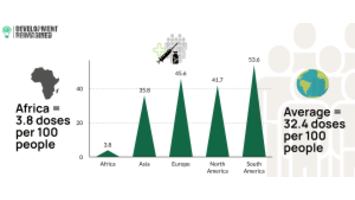Almost two years from the first reported cases of COVID-19 in December 2019, the world continues to vaccinate against the virus as a key prevention measure. With multiple variants in circulation, and different vaccines now in use, vaccination and booster administration continue to be recommended by the WHO and regional health organisations for high-risk populations, while social distancing measures have been relaxed across most of the world. At present, Africa as a region has achieved a 23% fully vaccinated rate, far below the global average of 65% fully vaccinated.
However, administering boosters – additional vaccine dose(s) given as a supplement to a primary dose course of a COVID-19 vaccine – is even worse in terms of the African continent being left behind.
So far, only 30 out of the 55 African nations are giving boosters, and the African region represents just 2% (54.2 million doses) out of a cumulative 2.5bn boosters given globally. In comparison, the Asia and Europe regions represent 66% (1.69 bn doses) and 13% (340 million doses) of global boosters administered, respectively.
Put differently and starkly – only 2.8% of the African population has received a booster.
This is not due to hesitancy.
Supply of vaccines for boosters in Africa is massively behind – with Africa recording 3.8 booster doses available per 100 persons, in comparison with the global average of 32.4 booster doses available per 100 persons. Hence, the current distribution of booster doses extends the inequity in access to pharmaceutical products we have seen since the onset of the pandemic, primarily due to hoarding. Richer nations began planning boosters for young children and wasting excess doses, prior to ensuring adequate supply for health workers and at-risk populations in Africa and other vulnerable regions.
That said, international mechanisms have been helpful to some degree in alleviating this overall inequitable situation. Nearly 70% of Africa’s supplies of COVID-19 vaccines have come via the COVAX mechanism, with the remainder somewhat evenly split between the AVAT mechanism, bi-/multilateral agreements, donations, and unknown sources. In other words: most vaccines used in African states have been donated.
While COVAX has never targeted a specific amount of vaccines to African countries, there is a bilateral partner that has – China; an assessment of UNICEF vaccine tracking numbers shows that of the total bilateral supply of vaccines to Africa, China accounts for 75% of donated doses and 61% of delivered doses to African nations.
We thus take the opportunity this month to review how China is doing on the pledge by President Xi Jinping at FOCAC in November 2021 to provide 1 billion vaccine doses to Africa: 600 million as direct doses and 400 million via support for production sites.
We find that to date China has completed 18% of the total pledge so far (or 30% of the doses pledge), due to an increase in donations after the November pledge. Joint Chinese and African manufacturing agreements, like those between Sinovac and Egypt’s Vacsera, also seem to be making progress though they have not yet started delivery as yet.
So what does this all mean? No doubt it means Africa’s plans for local vaccine and pharmaceutical manufacturing require continued focus. Being left behind was not a one off. Further, African countries can use this evidence to be more assertive with other countries and their pharma giants – equitable partnerships on manufacturing expertise, easing trade and IP laws as well as skills exchange opportunities are well overdue.

November 2022


